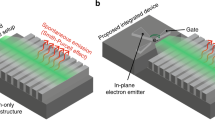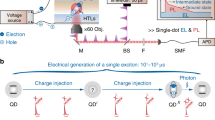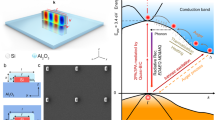Abstract
There is currently worldwide interest in developing silicon-based active optical components in order to leverage the infrastructure of silicon microelectronics technology for the fabrication of optoelectronic devices. Light emission in bulk silicon-based devices is constrained in wavelength to infrared emission, and in efficiency by the indirect bandgap of silicon1,2. One promising strategy for overcoming these challenges is to make use of quantum-confined excitonic emission in silicon nanocrystals. A critical challenge for silicon nanocrystal devices based on nanocrystals embedded in silicon dioxide has been the development of a method for efficient electrical carrier injection3,4,5,6,7,8. We report here a scheme for electrically pumping dense silicon nanocrystal arrays by a field-effect electroluminescence mechanism. In this excitation process, electrons and holes are both injected from the same semiconductor channel across a tunnelling barrier in a sequential programming process, in contrast to simultaneous carrier injection in conventional pn-junction light-emitting-diode structures. Light emission is strongly correlated with the injection of a second carrier into a nanocrystal that has been previously programmed with a charge of the opposite sign.
This is a preview of subscription content, access via your institution
Access options
Subscribe to this journal
Receive 12 print issues and online access
$259.00 per year
only $21.58 per issue
Buy this article
- Purchase on Springer Link
- Instant access to full article PDF
Prices may be subject to local taxes which are calculated during checkout




Similar content being viewed by others
References
Pavesi, L. & Lockwood, D. J. (eds) Silicon Photonics 1–52 (Topics in Applied Physics Series Vol. 94, Springer, 2004).
Green, M. A., Zhao, J., Wang, A., Reece, P. & Gal, M. Efficient silicon light-emitting diodes. Nature 412 805–808 (2001).
Valenta, J., Lalic, N. & Linros, J. Electroluminescence of single silicon nanocrystals. Appl. Phys. Lett. 84 1459–1461 (2004).
Franzo, G. et al. Electroluminescence of silicon nanocrystals in MOS structures. Appl. Phys. A 74, 1–5 (2002).
Photopoulos, P. & Nassiopoulou, A. G. Room-and low-temperature voltage tunable electroluminescence from a single layer of silicon quantum dots in between two thin SiO2 layers. Appl. Phys. Lett. 77, 1816–1818 (2000).
Fujita, S. & Sugiyama, N. Visible light-emitting devices with Schottky contacts on an ultrathin amorphous silicon layer containing silicon nanocrystals. Appl. Phys. Lett. 74, 308–310 (1999).
De la Torre, J. et al. Optical and electrical transport mechanisms in Si-nanocrystal-based LEDs. Physica E 17, 604–606 (2003).
De la Torre, J. et al. Optical properties of silicon nanocrystal LEDs. Physica E 16, 326–330 (2003).
Hanafi, H. & Tiwari, S. Fast and long retention-time nano-crystal memory. IEEE Trans. Elec. Dev. 43, 1553–1558 (1996).
Puzder, A., Williamson, A. J., Grossman, J. C. & Galli, G. Surface control of optical properties in silicon nanoclusters. J. Chem. Phys. 117, 6721–6729 (2002).
Walters, R. J. et al. Silicon optical nanocrystal memory. Appl. Phys. Lett. 85, 2622–2624 (2004).
Linnros, J., Lalic, N., Galeckas, A. & Grivickas, V. Analysis of the stretched exponential photoluminescence decay from nanometer-sized silicon crystals in SiO2 . J. Appl. Phys. 86, 6128–6134 (1999).
Feng, T., Yu, H., Dicken, M., Heath, J. & Atwater, H. A. Probing the size and density of silicon nanocrystals in nanocrystal memory device applications. Appl. Phys. Lett. (in the press).
Müeller, T., Heinig, K.-H. & Möller, W. Nanocrystal formation in Si implanted thin SiO2 layers under the influence of an absorbing interface. Mater. Sci. Eng. B 101, 49–54 (2003).
Acknowledgements
This work was supported by Intel Corporation and the Air Force Office of Scientific Research (#FA9550-04-1-0434). R.J.W. acknowledges National Defense Science and Engineering Graduate Fellowship support through the Army Research Office.
Author information
Authors and Affiliations
Corresponding author
Ethics declarations
Competing interests
The authors declare no competing financial interests.
Rights and permissions
About this article
Cite this article
Walters, R., Bourianoff, G. & Atwater, H. Field-effect electroluminescence in silicon nanocrystals. Nature Mater 4, 143–146 (2005). https://doi.org/10.1038/nmat1307
Received:
Accepted:
Published:
Issue Date:
DOI: https://doi.org/10.1038/nmat1307
This article is cited by
-
Prospects and applications of on-chip lasers
eLight (2023)
-
Effects of field enhanced charge transfer on the luminescence properties of Si/SiO2 superlattices
Scientific Reports (2022)
-
Photoluminescence enhancement of silicon nanocrystals by excimer laser implanted gold nanoparticles
Applied Physics A (2022)
-
Selective photosensitivity of metal–oxide–semiconductor structures with SiOx layer annealed at high temperature
Journal of Materials Science: Materials in Electronics (2020)
-
Silicon nanowire luminescent sensor for cardiovascular risk in saliva
Journal of Materials Science: Materials in Electronics (2020)



